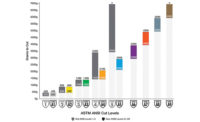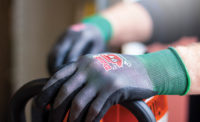New glove testing standards
10 things you need to know

If you work in the health and safety industry, chances are that you’ve been hearing all of the buzz about the recent updates to the ANSI/ISEA and EN 388 glove testing processes and classifications. If you’re curious about what these changes will entail, you’ve come to the right place; we’ve compiled a list of the ten major things that you need to know about the new testing standards, and how they will affect you and your customers.
What you need to know
1. The first crucial thing you need to know is that these changes are designed to improve the accuracy of the testing by making it easier for glove manufacturers to replicate their testing results. For this reason, although you might be feeling a bit overwhelmed by the thought of having to alter your glove testing process, in the long run, these changes will result in an increase in employee safety in the workplace. The standards committee believes that these changes will make it easier for end users to choose appropriate work gloves for their industries, and consequently, help to lower the number of hand-related injuries in the workplace.
2. If you’re located in North America, the new ANSI/ISEA 105-2016 standard will be your main concern; the updates were officially approved in February 2016, and are therefore now in effect.
3. One of the main changes to the old ANSI/ISEA standard is the increase in the number of cut levels from five to nine. The ANSI/ISEA committee realized that since the old cut level 4 category covered such a large range (from 1500 to 3499 grams), dividing this large spectrum into smaller sections would result in more differentiation between products. The thought was that this change would benefit end users the most, since it would improve the overall accuracy of glove selection, and therefore, bring about a higher level of safety on the jobsite. For this reason, this change will also prevent end users from assuming that all gloves within the old cut level 4 category provide the same amount of cut protection.
4. In order to keep confusion to a minimum during this transitional stage, the new cut levels will now have an A in front of them, instead of just a number. (For example, a glove that offers 200 to 499 grams of cut protection will be rated ANSI level A1 for cut resistance).
5. Here are the cut test requirements for the new ANSI levels:
A1: 200-499 grams to cut
A2: 500-999 grams to cut
A3: 1000-1499 grams to cut
A4: 1500-2199 grams to cut
A5: 2200-2999 grams to cut
A6: 3000-3999 grams to cut
A7: 4000-4999 grams to cut
A8: 5000-5999 grams to cut
A9: 6000+ grams to cut
Wondering how the new cut levels compare to the old ones? See figure 1 for a comparison chart for reference.
6. Another significant change to the old ANSI/ISEA standard will be the addition of a new needle stick puncture test; by improving the way in which the levels of puncture resistance are classified, this will allow for a higher level of protection against puncture threats in the workplace. Also, since the ISO 13997 (TDM) machines generally produce much more consistent results than CPPT machines, the TDM machine is now the recommended testing machine for all future EN 388 and ANSI/ISEA testing. By encouraging everyone to use the same testing machine, the hope is that it will help standardize the way in which cut levels are assigned, meaning that test results from different glove manufacturing companies will be easier to interpret and compare.
7. The new EN 388 standard is the one that will directly affect European customers. While the changes to this standard are still currently pending review, they are expected to be approved during the summer of 2016. Note: Unless this standard becomes adopted by other countries in the future, these changes should only affect those living in the EU.
8. The EN 388 standard needs to be revised due to inconsistences with test results – especially with the cut and abrasion tests. For this reason, the main changes to the EN 388 standard will include the adoption of the ISO 13997 (TDM) cut test as the preferred testing method, the use of a different kind of abrasive paper to increase the accuracy of testing results, and the calculation of test results in Newtons instead of grams. The new EN 388 standard will also include testing for impact protection. For a greater level of consistency across the board, the last six EN 388 levels will also match the new ANSI/ISEA 105 levels, but the EN 388 levels will be designated using the letters A to F.
9. Here are the requirements for the new EN 388 levels:
A: 2 Newtons = 203 grams to cut
B: 5 Newtons = 509 grams to cut
C: 10 Newtons = 1019 grams to cut
D: 15 Newtons = 1529 grams to cut
E: 22 Newtons = 2243 grams to cut
F: 30 Newtons = 3059 grams to cut
10. Wondering when you’ll have to make these changes to your testing process? If you’re in North America, don’t stress: there isn’t currently a specific deadline for retesting your gloves under the new ANSI/ISEA 105-2016 standard. However, the sooner they’re retested, the better, since your gloves won’t be certified under the new standards until the testing is conducted. Since the new EN 388 standard is still pending approval, a deadline for retesting doesn’t currently exist. However, it is expected that there will be a mandatory testing deadline for European manufacturers in the future, so make sure you keep an eye out for it!
We hope you’re feeling more informed about what the major changes to the standards are and why they’re being made. Once they’re fully implemented, these new standards will make a world of difference: they’ll allow for a higher level of consistency among glove manufacturers, as well as greatly increase the accuracy of the testing processes overall. It is our hope that in the long run, these changes will result in a significant decrease in the number of hand-related injuries in the workplace as well.
Looking for a reprint of this article?
From high-res PDFs to custom plaques, order your copy today!





